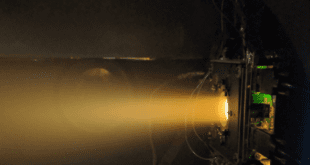 Paris, 8 November 2020. – The French startup ThrustMe and the Luxembourg new space company Spacety launched the world’s first iodine propelled satellite into space, the companies said.
Paris, 8 November 2020. – The French startup ThrustMe and the Luxembourg new space company Spacety launched the world’s first iodine propelled satellite into space, the companies said.
Spacety’s Beihangkongshi-1 satellite carrying ThrustMe’s innovative propulsion system was successfully launched on a CZ-6 Long March 6 rocket from Taiyuan in China, the companies said.
Iodine can be stored as a solid and doesn’t require any complex or costly high-pressure storage tanks like conventional gaseous propellants such as xenon, ThrustMe and Spacety say. “This also means that the propulsion system can be delivered pre-filled, which greatly simplifies satellite integration and testing. Considering the high production cost of xenon, and the predicted supply problems to meet growing demands from satellite constellations, iodine is seen as an important next-generation propellant to enable sustainability of the space industry.”
The two companies see the launch of ThrustMe’s propulsion system on Spacety’s satellite as starting point of “a significant commercial collaboration between the two companies.” They jointly demonstrated the first iodine propulsion system in 2019.
ThrustMe is an in-space propulsion company based in the Paris-region, France, which spun out from a research lab of Ecole Polytechnique and the French National Centre for Scientific Research (CNRS).
Spacety was founded in 2016 in China as one of the first commercial Chinese aerospace companies and established its international headquarters in Luxembourg in 2019. The company has so far developed, launched, and operated 18 satellites for science and technology demonstration missions.
 SpaceWatch.Global An independent perspective on space
SpaceWatch.Global An independent perspective on space




